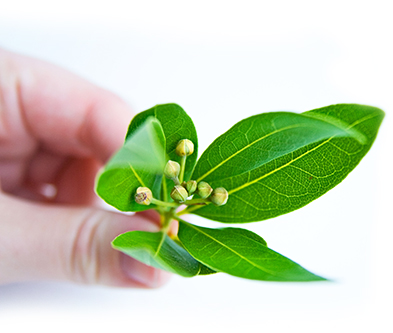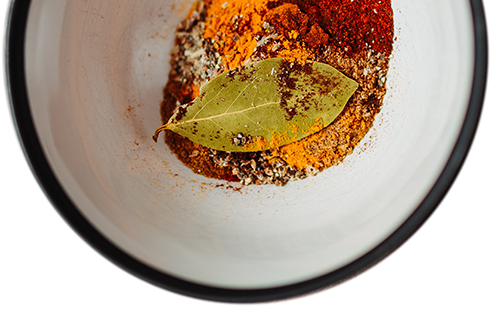BAY LEAF BENEFITS

LAUREL LEAVES
Laurus nobilis
Also called bay leaves, this aromatic herb is hand-picked from the evergreen Laurus nobilis, or bay laurel tree which is native to the Mediterranean.
VARIETIES:
The two main varieties are Mediterranean (Turkish) and Californian. In fact, the two types of bay leaves are not even directly related. Fresh California bay leaves (Umbellularia californica, Lauraceae), come from a tree that has a decidedly more potent eucalyptus flavor that can easily dominate a dish if you're not careful, while Turkish bay is much milder.
The oval-shaped Mediterranean or "true laurel" leaves are the variety most commonly found in the spice aisle. Largely supplied by Turkey, these have a more subtle flavor than the oilier, more narrow leaves produced by laurel trees grown in California.
While fresh leaves are rarely available in markets today, dried bay leaves have become one of the most commonly used herbs in cuisines around the world. The leaves impart a delicate aromatic scent and a sweet, but mildly bitter flavor.
HOW TO USE?

Dried bay leaves may be used whole or crumbled into your recipes. The leaves are bitter and hard to chew, so remember to remove whole leaves from your recipes before serving, or crumble them very finely. Add a leaf or two to flavor marinades, spaghetti sauce, chili, meat stews and bean, split pea or vegetable soups.
BOUQET GARNI:
Combined with parsley and thyme, bay leaves are also used to make a classic bouquet garni. Traditionally, these herbs are tied together (or wrapped in cheesecloth), added to a dish, allowed to simmer and lifted out at the end of cooking.
HOW TO STORE?
Store dried bay leaves in a cool, dry and dark place for up to twelve months.
HEALTH BENEFITS OF BAY LEAF

• The spice contains many notable plants derived compounds, minerals and vitamins that are essential for optimum health.
• This spice has many volatile active components such as a-pinene, ß-pinene, myrcene, limonene, linalool, methyl chavicol, neral, a-terpineol, geranyl acetate, eugenol, and chavicol. These compounds are known to have been antiseptic, anti-oxidant, digestive, and thought to have anti-cancer properties.
• Fresh leaves are very rich source of vitamin-C; provide 46.5 mg or 77.5% of RDA per 100 g. Vitamin-C (ascorbic acid) is one of the powerful natural anti-oxidant that help remove harmful free radicals from the body. Ascorbic acid also has immune booster, wound healing and anti-viral effects.
• Furthermore, its fresh leaves and herb parts are very good in folic acid. Folates are important in DNA synthesis and when given during the peri-conception period, they can help prevent neural tube defects in the baby.
• Bay leaves are an excellent source of vitamin A; Vitamin A is a natural antioxidant and is essential for healthy visual sight. It is also required for maintaining mucusa and skin health. Consumption of natural foods rich in vitamin A has been found to help to protect from lung and oral cavity cancers.
• The spice is indeed a very good source of many vitamins such as niacin, pyridoxine, pantothenic acid and riboflavin. These B-complex groups of vitamins help in enzyme synthesis, nervous system function, and regulating body metabolism.
• Bay Leaves is a good source of minerals like copper, potassium, calcium, manganese, iron, selenium, zinc and magnesium. Potassium is an important component of cell and body fluids that helps control heart rate and blood pressure. Manganese and copper are used by the body as co-factors for the antioxidant enzyme, superoxide dismutase. Iron is essential for red blood cell production and as a co-factor for cytochrome-oxidase enzymes.
MEDICINAL USES OF BAY LEAF

Bay leaves yield an essential oil that is used in cooking and in treatment of various ailments. The essential oil that is obtained from the fruit is used in making soap.
• Medicinally, the benefits of the bay leaf and its berries are plentiful. It has astringent, diuretic, and appetite stimulant properties.
• Essential oil from the bay leaves contains mostly cineol (50%); furthermore, eugenol, chavicol, acetyl eugenol, methyl eugenol, a- and ß-pinene, phellandrene, linalool, geraniol and terpineol are also found.
• Infusions of herb parts are reputed to soothe stomach ulcers and help relieve flatulence and colic pain.
• The lauric acid in the bay laurel leaves has insect repellent properties.
• The components in the essential oil can also be used in many traditional medicines in the treatment of arthritis, muscle pain, bronchitis and flu-symptoms.